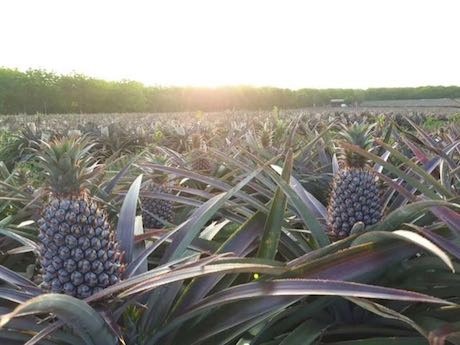Pineapple is the third largest tropical fruit product in the world, only after banana and mango. There are 1,000,000 hectares of pineapple in the world. Most of them are distributed in Asia and Africa. There are 400,000 hectares of pineapple in Asia, of which about 70,000 hectares are in China. Pineapple is mostly grown in Guangdong, Hainan, Yunnan, Guangxi, Fujian, Taiwan in China. Eighty four percent of pineapple was grown in Guangdong and Hainan and the main cultivar of pineapple in China is Comte de Paris, introduced from Philippines, accounting for more than 80% of the total pineapple production. Most of pineapples in China are sold as fresh fruit.

In the last 15 years, trade in fresh pineapples increased by 14% every year. Tinned pineapple is one of the best canned fruits in the world. There are 1,000,000 tons of canned pineapple traded among different countries every year. Pineapple fruit is also made into canned fruit juice. In China, most of the pineapples are sold in the home market and the half of them comes from Hainan province.
"Although the pineapple industry plays an important role in economics of tropical- and subtropical-areas in China, some risks have occurred in recent years. These included the sale period, the cultivation of different varieties, the unstable volume of fruits for processing companies, plant disease, and so on. These critical issues should be given attention, because the future development of the pineapple industry in China might be hindered", the scientists of the Chinese Academy of Tropical Agricultural Sciences in Haikou (China) explain.
The sale period is centralized, the fruits cannot be sold in short time in harvest season. Most pineapples are harvested from March to May. They cannot be sold fully in such a short time and cannot be stored for a long time. If they are not sold in two to three weeks, the fruits deteriorate. Furthermore, litchi is harvested in May and June and competes for custom. These conditions cause the low price of pineapple and the income of some farmers can not compensate for the planting costs.
In China, only a small part of production is processed into canned fruit, juice or other products. In a year when the price of fresh fruit is high, the company cannot buy enough fruits for processing. When the price of fresh fruit was low, the company cannot buy too many fruits. Thus, the volumes being unstable, the companies will not invest much capital for research and buying advanced facilities.
As regards fruit diseases, Black rot is an important disease for pineapple fruit. Sometimes, the disease rate can reach to 40% with heavy losses for farmers.
"To resolve these problems, new varieties for harvesting throughout the year should be selected to improve the profit of the farmers and to adjust pineapple harvest period to the whole year. More work should be done in the technology on inducing inflorescence of new varieties, on precision fertilization for new varieties, (although some new varieties have excellent qualities and production, their characteristics in physiology are unknown to farmers), on propagating plantlets fast and at low cost and on prevention and control of disease in fruits before harvesting", the scientists conclude.
Source: Haiyan Shu, Wei Sun, Keming Li, Guiying Xu, Rulin Zhan, Shenghe Chang, 'The Situation and Challenges of Pineapple Industry in China', 2019, Agricultural Sciences, Vol. 10, No. 5, Article ID:92640










